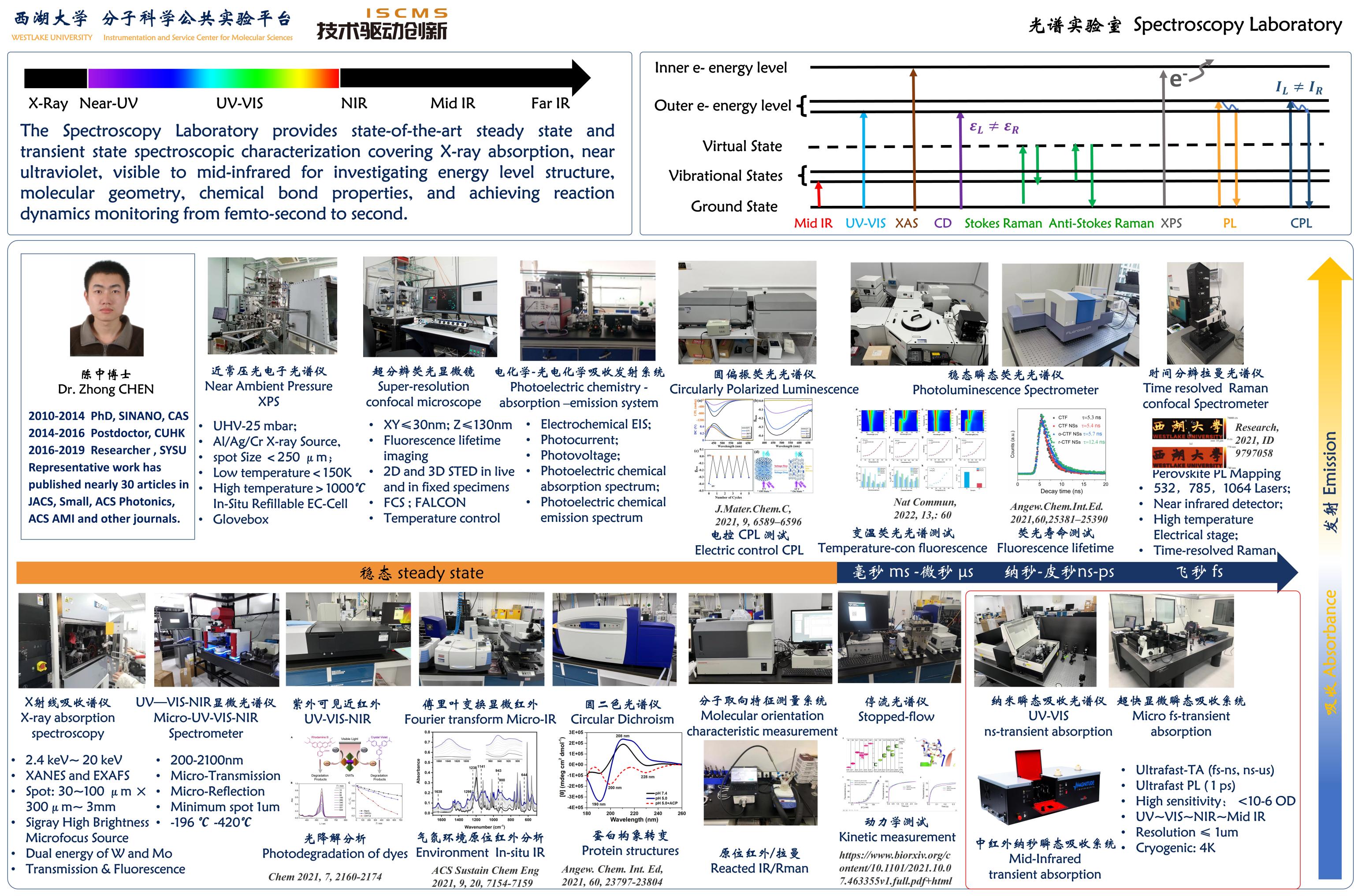
光谱分析法是在电磁辐射下,粒子的电子能级和振动能级发生改变,因而产生吸收、发射、或者散射等行为,以确定其化学成份、分子构像、相对含量及反应动力学过程的方法,它具有灵敏度高、样品损坏少、微区分析方便、分析速度快的优点。理化平台光谱实验室提供最先进的从近紫外、可见光到中红外区的稳态和瞬态光谱表征和微区成像表征,用于能级结构、分子几何、化学键性质的分析,实现从皮秒到秒的反应动力学监测。 目前已到位的仪器包括紫外可见近红外分光光度计、快速成像显微拉曼光谱仪、瞬态/稳态荧光光谱仪、傅里叶变换显微红外光谱仪、圆二色光谱仪。同时,光谱实验室配有专业的实验技术员培训用户正确地使用仪器,维护仪器的正常运行,开发仪器的功能。
紫外可见近红外分光光度计(岛津UV-2700 and UV-3600 plus)能实现样品在200nm-3000nm范围光谱、光度及动力学的测试。本仪器配有积分球附件用于固体样品的透射和反射测试,温控附件用于样品的变温光谱测量。同时仪器还配有薄膜支架、旋转膜支架、镜面反射装置 (5°入射角)、偏振附件,满足各类晶圆、薄膜等材料多性能的测试。更多信息见 https://iscps.westlake.edu.cn/info/1024/1191.htm
快速成像显微拉曼光谱仪(WITec alpha300R)配置473nm、532nm、633nm的激光器及低波数、低温(77k-600k)、EMCCD、光电流成像等一系列高端附件。特别是在成像方面,通过光纤小孔实现稳定的共聚焦,保证了其快速成像的特点,同时使微区成像分辨率达到了横向350nm,纵向900nm。本仪器配置的TrueSurface附件更是保证了即使长时间成像也能不脱焦,保证图像清晰。本套系统是分子成分和结构的分析,多层二维材料、材料应力监控、材料纵向的无损分析、细胞组分成像分析的理想工具。更多信息见 https://iscps.westlake.edu.cn/info/1024/1451.htm
稳态瞬态荧光光谱仪(FLS1000)是一套集合稳态测试、荧光寿命测试和磷光寿命测试的模块化系统。可用于测量紫外-可见-近红外光谱范围内的稳态光谱,使用时间校正单光子计数方法和多通道扫描技术可以测量100皮秒到50微秒之间的荧光衰减和时间范围在1微秒到10秒之间的磷光衰减。本仪器配置9个波长的激光器,四个检测器以及X射线光源、积分球附件、自动偏振及牛津温控附件等。在应用上可以进行荧光激发/发射,三维光谱,磷光光谱,变温荧光光谱,上转换材料光谱,240-1700nm偏振光谱测试,230-5500nm稳态光谱测试、量子效率测试及闪烁晶体的研究,系统灵敏度可达到SN:24000:1。特别是,本仪器上搭配的多个激光器、微秒闪烁氙灯和多种类型的探测器,满足在230-1700nm范围的瞬态光谱测试,其时间尺度跨越9个数量级,完成从纳秒到秒级的测试。更多信息见 https://iscps.westlake.edu.cn/info/1024/1291.htm
傅里叶变换显微红外光谱仪(Nicolet iS50)采用最新一代磁浮式控制平面镜麦克尔逊干涉仪,采用三维激光控制自动调整和每秒130,000次高速动态准直调整功能,确保长期检测的高精度、超高稳定性,无光谱偏离和失真。光学台内置常规透射模块、近红外模块、ATR模块并且连接显微红外系统,使用每个模块不需要安装和拆卸,满足粉末、液体、薄膜、块材料及微小材料等各类样品的测试。其显微红外系统能进行微区的Mapping扫描,在药物、复合材料的成份分析中提供最直接的微区测试结果。此外,光学台多个光路接口,可提供光引出和引入的平行和聚焦光路,扩展各种红外联用检测系统,包括与气相、热重、流变、凝胶色谱等仪器联机。更多信息见 https://iscps.westlake.edu.cn/info/1024/1342.htm
圆二色光谱仪(Chirascan Plus V100)能够用于研究生物大分子的二级结构和三级结构、有机化合物的构型构象、聚合物高分子的手性立体结构, 以及分子的构象变化和分子间的相互作用。本仪器上除了常规的液体圆二色测试外,还配置固体样品的透射和漫反射检测附件、旋光色散检测附件、以及磁圆二色模块来满足客户的各种测试需求。此外,仪器配有的停流动力学附件可以研究毫秒级的化学反应,成为快速反应动力学研究的有力工具。整套系统不仅服务于在生命科学、化学、药学、食品科学等学科领域的分子结构与功能研究, 也广泛应用于药物研发、药物筛选等应用领域,如生物大分子药物的高级结构 HOS ( Higher Order Structure ) 研究与比对,生物仿制药(Biosimilar) 的结构相似性研究, 以满足药物审批研究监管机构(如FDA 、EMA、CFDA等) 对新药申报中提报相关结构数据的要求。更多信息见 https://iscps.westlake.edu.cn/info/1024/1344.htm
Spectrum analysis method is a kind of useful tool for determining chemical composition, molecular structure, relative content or kinetics process though investigating the absorbance, emission, or scattering behaviors created by electronic level transition or vibrational level transition generated under electromagnetic radiation. This method has the virtue of high sensitivity, low destructive on sample, microanalysis, fast-analysis to study physico-chemical properties. The Spectroscopy Laboratory in ISCPS provides the state-of-the-art steady-state and transient-state spectroscopic and micro-mapping characterization instruments covering near ultraviolet, visible to mid-infrared for investigating energy level structure, molecular geometry, chemical bond properties, and achieving reaction kinetics monitoring from picosecond to second. In present, those instruments include UV-VIS-NIR spectrophotometer, Fast-mapping micro-Raman spectrometer, steady-state/transient-state fluorescence spectrometer, Fourier transform micro-infrared spectrometer, circular dichroism spectrometer. At the same time, the lab equips with a professional laboratory technician to train users to operate equipment correctly, maintain the normal running of equipment and exploit new technology.
Ultraviolet-Visible-Near infrared spectrophotometer (Shimadzu UV - 2700 and UV - 3600 plus) can provide spectrum/ photometric/ kinetic measurement from 200 nm to 3000 nm. It equips with integrating sphere accessory for transmittance, reflection measurement of solid sample and temperature-control sample chamber for variable-temperature measurement of liquid sample. Besides, this spectrophotometer also equips with thin-film holder, rotating film holder, specular reflector device (5 ° Angle) and polarization accessory to realize multi-performance testing of glass, wafer, metal, thin film or macromolecule materials. https://iscps.westlake.edu.cn/info/1024/1191.htm
Fast-mapping micro Raman spectrometer (WITec alpha300R) equips with 473nm, 532nm, 633nm lasers and a series of functional accessories such as low wavenumber, low temperature (77k-600k), EMCCD, photocurrent imaging , etc. In terms of mapping, the confocal function realized by a small optical fiber aperture to guarantee the stable, fast mapping characteristic, which also make the micro-area resolution reach 350nm in transverse and 900nm in longitudinal. Especially, the equipped TrueSurface function can effectively avoid defocus when perform long time scanning. This spectrometer can be broadly applied in molecular composition analysis, two-dimensional material, material stress monitoring, longitudinal nondestructive analysis of materials, and cell imaging. https://iscps.westlake.edu.cn/info/1024/1451.htm
Steady state and time-resolved Photoluminescence Spectrometer (Edinburgh FLS1000) combined steady state, fluorescence lifetime and phosphorescence lifetime spectrometer is a modular system for measuring steady state spectra in the UV-VIS-NIR spectral range, together with fluorescence decays in the time range between 100ps and 50μs using the method of Time Correlated Single Photon Counting and phosphorescence decays in the time range between 1μs and10 seconds using the technique of Multi-Channel Scaling. It is equipped with 9 wavelength lasers, four detectors, an X-ray source, an integrating sphere, an automatic polarization device and an Oxford temperature control accessory, all of which make this high-equipped instrument serve broadly in a variety of fields such as fluorescence excitation/emission, time-resolved spectrum, three-dimensional spectrum, phosphorescent spectrum, variable temperature fluorescence spectrum, up-conversion material spectrum, 240-1700nm polarization spectrum, 230-5500nm steady-state spectrum, quantum efficiency measurement and scintillation crystals research (X-ray source). The standard instrument has a guaranteed sensitivity of 24,000:1 with double monochromators for the Signal to Noise Ratio of the water Raman signal. In addition, it equips with 9 lasers, xenon flashlamp together with multiple detectors ensure nine orders of magnitude time-resolved spectrum covering nanoseconds to seconds ranges from 230 to 1700nm. https://iscps.westlake.edu.cn/info/1024/1571.htm
Fourier transform micro-infrared spectrometer (Nicolet iS50) use the latest generation of maglev control plane mirror michelson interferometer, and the 3D laser Auto-TuneTM and 130000 times/s high-speed Continuous Dynamic Alignment, which ensure long-term detection with high precision, high stability and without spectral deviation and distortion. This spectrometer system is built-in with conventional transmission module, near-infrared module, ATR module and connected to the micro-infrared system, which achieve the measurement of various samples such as powder, liquid, film, block material and micro-material. Its micro-infrared system can carry out mapping scanning of micro-area that provide the image results for component analysis of drugs or composite materials. In addition, this system has multiple optical path hubs, providing extra focused optical paths for import and export of infrared light to extend infrared coupling systems, including connecting with gas phase, thermogravimetric, rheological, and gel chromatography. https://iscps.westlake.edu.cn/info/1024/1342.htm
Circular dichroism spectrometer (Chirascan Plus V100) is used to study the secondary structure and tertiary structure of biological macromolecules, configuration conformation of organic compounds, chiral stereoscopic structure of macromolecule polymer, and molecular conformational changes and molecular interactions. Besides the routine liquid test, this instrument is also configured with transmission and diffuse reflection accessory of solid samples, optical rotatory dispersion accessory, and magnetic circular dichroism modules to diversify the measurement. In particular, stop-flow accessory can be used to study the chemical reaction at the millisecond level and become a powerful tool for the study of the kinetics of rapid reactions. In a word, this system not only serves for investigating molecular structure and functions in life science, chemistry, pharmacy and food science, but also widely used in drug research, drug screening and other application fields, such as research and comparison in Higher Order Structure of biological macromolecular drugs, or structural similarity research in Biosimilar, which meet the structure-relevant requirements in new drug application process supervised by drug approval institute (such as the FDA, EMA, the CFDA, etc.). https://iscps.westlake.edu.cn/info/1024/1344.htm